American Sign Language: Cochlear Implant Structure, Functionality
VerifiedAdded on 2023/06/09
|6
|1632
|155
Essay
AI Summary
This essay provides a comprehensive overview of cochlear implants, devices used to provide a sense of sound to individuals with hearing loss. It details the three main parts of the implant: the microphone, speech processor, and transmitter/stimulator, explaining how these components work together to convert sound into electrical impulses that stimulate the auditory nerve. The essay also discusses the advantages of cochlear implants, such as improved social connection and increased independence, as well as the disadvantages, including difficulty prioritizing sounds in noisy environments and the need for ongoing maintenance. It highlights that the success of cochlear implants can vary and emphasizes the importance of post-implantation training for optimal results. The essay concludes by noting that both patients and healthcare professionals should be well-informed about the device and its potential outcomes before implementation.
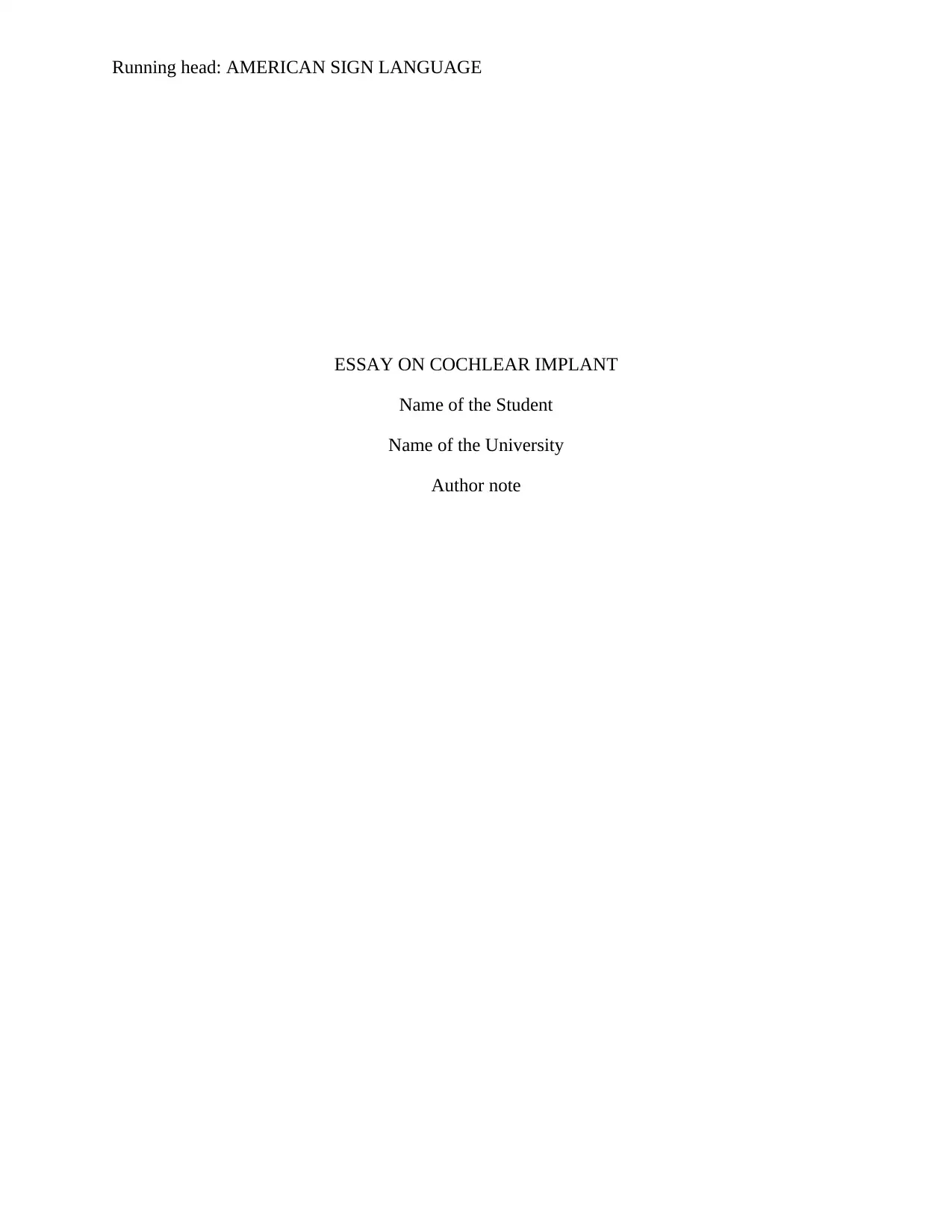
Running head: AMERICAN SIGN LANGUAGE
ESSAY ON COCHLEAR IMPLANT
Name of the Student
Name of the University
Author note
ESSAY ON COCHLEAR IMPLANT
Name of the Student
Name of the University
Author note
Paraphrase This Document
Need a fresh take? Get an instant paraphrase of this document with our AI Paraphraser
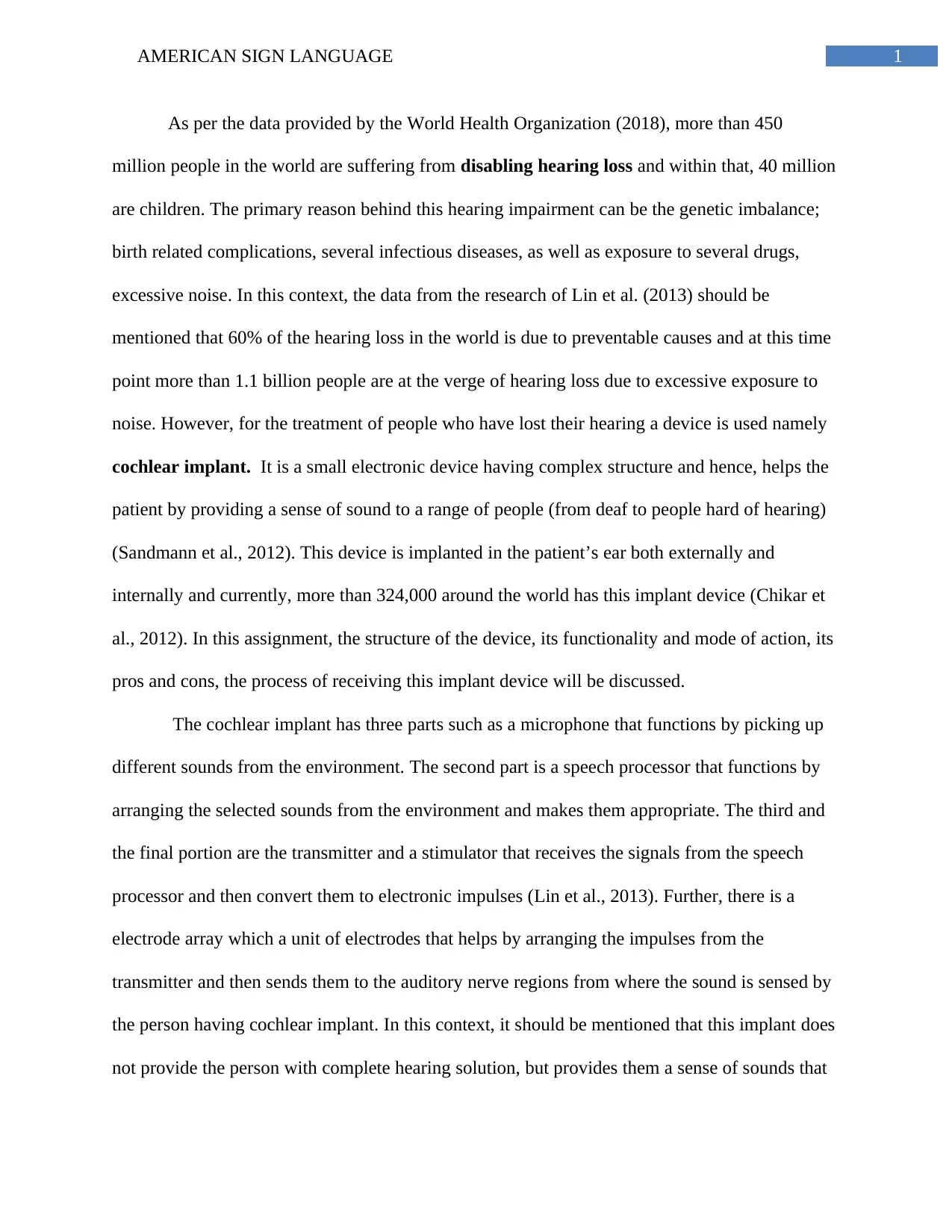
1AMERICAN SIGN LANGUAGE
As per the data provided by the World Health Organization (2018), more than 450
million people in the world are suffering from disabling hearing loss and within that, 40 million
are children. The primary reason behind this hearing impairment can be the genetic imbalance;
birth related complications, several infectious diseases, as well as exposure to several drugs,
excessive noise. In this context, the data from the research of Lin et al. (2013) should be
mentioned that 60% of the hearing loss in the world is due to preventable causes and at this time
point more than 1.1 billion people are at the verge of hearing loss due to excessive exposure to
noise. However, for the treatment of people who have lost their hearing a device is used namely
cochlear implant. It is a small electronic device having complex structure and hence, helps the
patient by providing a sense of sound to a range of people (from deaf to people hard of hearing)
(Sandmann et al., 2012). This device is implanted in the patient’s ear both externally and
internally and currently, more than 324,000 around the world has this implant device (Chikar et
al., 2012). In this assignment, the structure of the device, its functionality and mode of action, its
pros and cons, the process of receiving this implant device will be discussed.
The cochlear implant has three parts such as a microphone that functions by picking up
different sounds from the environment. The second part is a speech processor that functions by
arranging the selected sounds from the environment and makes them appropriate. The third and
the final portion are the transmitter and a stimulator that receives the signals from the speech
processor and then convert them to electronic impulses (Lin et al., 2013). Further, there is a
electrode array which a unit of electrodes that helps by arranging the impulses from the
transmitter and then sends them to the auditory nerve regions from where the sound is sensed by
the person having cochlear implant. In this context, it should be mentioned that this implant does
not provide the person with complete hearing solution, but provides them a sense of sounds that
As per the data provided by the World Health Organization (2018), more than 450
million people in the world are suffering from disabling hearing loss and within that, 40 million
are children. The primary reason behind this hearing impairment can be the genetic imbalance;
birth related complications, several infectious diseases, as well as exposure to several drugs,
excessive noise. In this context, the data from the research of Lin et al. (2013) should be
mentioned that 60% of the hearing loss in the world is due to preventable causes and at this time
point more than 1.1 billion people are at the verge of hearing loss due to excessive exposure to
noise. However, for the treatment of people who have lost their hearing a device is used namely
cochlear implant. It is a small electronic device having complex structure and hence, helps the
patient by providing a sense of sound to a range of people (from deaf to people hard of hearing)
(Sandmann et al., 2012). This device is implanted in the patient’s ear both externally and
internally and currently, more than 324,000 around the world has this implant device (Chikar et
al., 2012). In this assignment, the structure of the device, its functionality and mode of action, its
pros and cons, the process of receiving this implant device will be discussed.
The cochlear implant has three parts such as a microphone that functions by picking up
different sounds from the environment. The second part is a speech processor that functions by
arranging the selected sounds from the environment and makes them appropriate. The third and
the final portion are the transmitter and a stimulator that receives the signals from the speech
processor and then convert them to electronic impulses (Lin et al., 2013). Further, there is a
electrode array which a unit of electrodes that helps by arranging the impulses from the
transmitter and then sends them to the auditory nerve regions from where the sound is sensed by
the person having cochlear implant. In this context, it should be mentioned that this implant does
not provide the person with complete hearing solution, but provides them a sense of sounds that
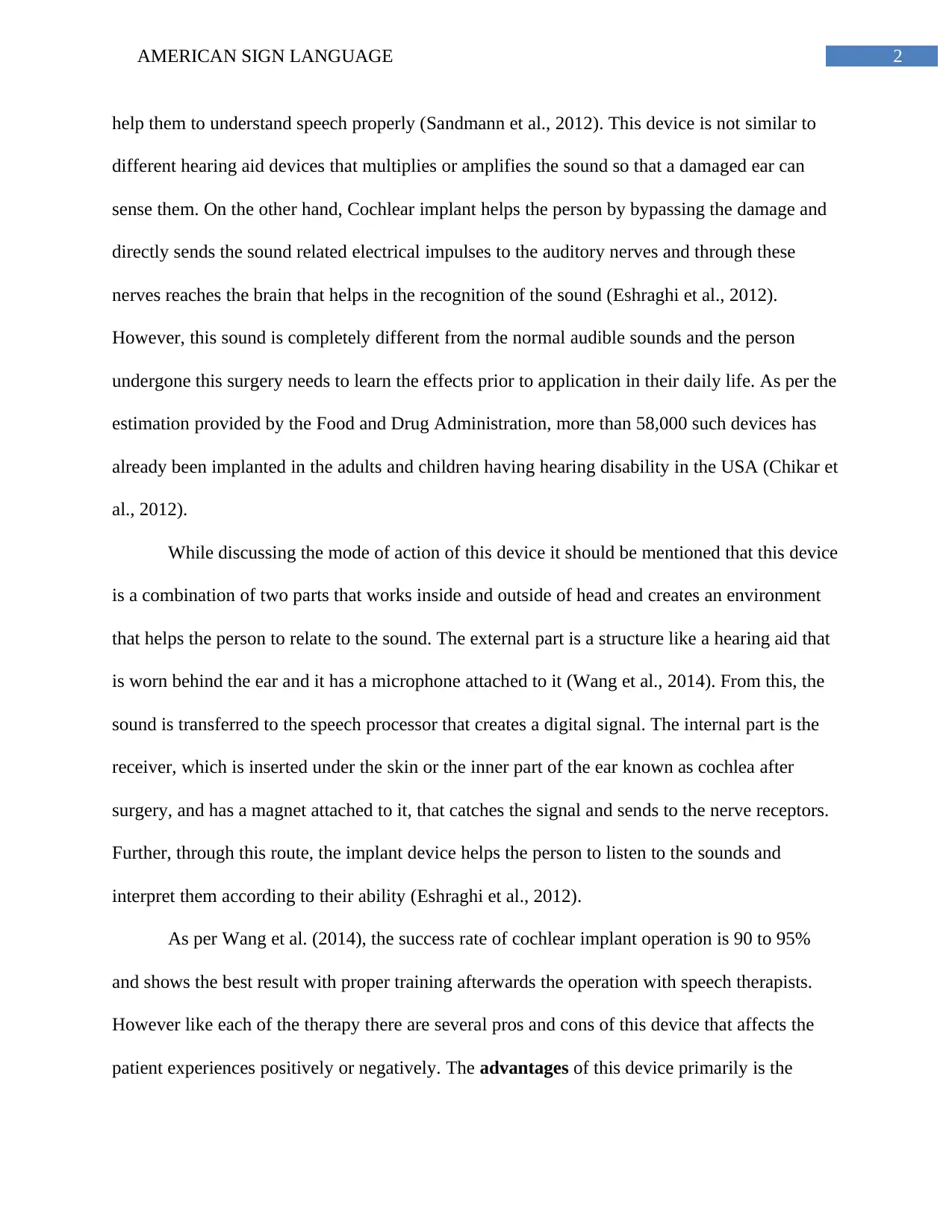
2AMERICAN SIGN LANGUAGE
help them to understand speech properly (Sandmann et al., 2012). This device is not similar to
different hearing aid devices that multiplies or amplifies the sound so that a damaged ear can
sense them. On the other hand, Cochlear implant helps the person by bypassing the damage and
directly sends the sound related electrical impulses to the auditory nerves and through these
nerves reaches the brain that helps in the recognition of the sound (Eshraghi et al., 2012).
However, this sound is completely different from the normal audible sounds and the person
undergone this surgery needs to learn the effects prior to application in their daily life. As per the
estimation provided by the Food and Drug Administration, more than 58,000 such devices has
already been implanted in the adults and children having hearing disability in the USA (Chikar et
al., 2012).
While discussing the mode of action of this device it should be mentioned that this device
is a combination of two parts that works inside and outside of head and creates an environment
that helps the person to relate to the sound. The external part is a structure like a hearing aid that
is worn behind the ear and it has a microphone attached to it (Wang et al., 2014). From this, the
sound is transferred to the speech processor that creates a digital signal. The internal part is the
receiver, which is inserted under the skin or the inner part of the ear known as cochlea after
surgery, and has a magnet attached to it, that catches the signal and sends to the nerve receptors.
Further, through this route, the implant device helps the person to listen to the sounds and
interpret them according to their ability (Eshraghi et al., 2012).
As per Wang et al. (2014), the success rate of cochlear implant operation is 90 to 95%
and shows the best result with proper training afterwards the operation with speech therapists.
However like each of the therapy there are several pros and cons of this device that affects the
patient experiences positively or negatively. The advantages of this device primarily is the
help them to understand speech properly (Sandmann et al., 2012). This device is not similar to
different hearing aid devices that multiplies or amplifies the sound so that a damaged ear can
sense them. On the other hand, Cochlear implant helps the person by bypassing the damage and
directly sends the sound related electrical impulses to the auditory nerves and through these
nerves reaches the brain that helps in the recognition of the sound (Eshraghi et al., 2012).
However, this sound is completely different from the normal audible sounds and the person
undergone this surgery needs to learn the effects prior to application in their daily life. As per the
estimation provided by the Food and Drug Administration, more than 58,000 such devices has
already been implanted in the adults and children having hearing disability in the USA (Chikar et
al., 2012).
While discussing the mode of action of this device it should be mentioned that this device
is a combination of two parts that works inside and outside of head and creates an environment
that helps the person to relate to the sound. The external part is a structure like a hearing aid that
is worn behind the ear and it has a microphone attached to it (Wang et al., 2014). From this, the
sound is transferred to the speech processor that creates a digital signal. The internal part is the
receiver, which is inserted under the skin or the inner part of the ear known as cochlea after
surgery, and has a magnet attached to it, that catches the signal and sends to the nerve receptors.
Further, through this route, the implant device helps the person to listen to the sounds and
interpret them according to their ability (Eshraghi et al., 2012).
As per Wang et al. (2014), the success rate of cochlear implant operation is 90 to 95%
and shows the best result with proper training afterwards the operation with speech therapists.
However like each of the therapy there are several pros and cons of this device that affects the
patient experiences positively or negatively. The advantages of this device primarily is the
⊘ This is a preview!⊘
Do you want full access?
Subscribe today to unlock all pages.

Trusted by 1+ million students worldwide
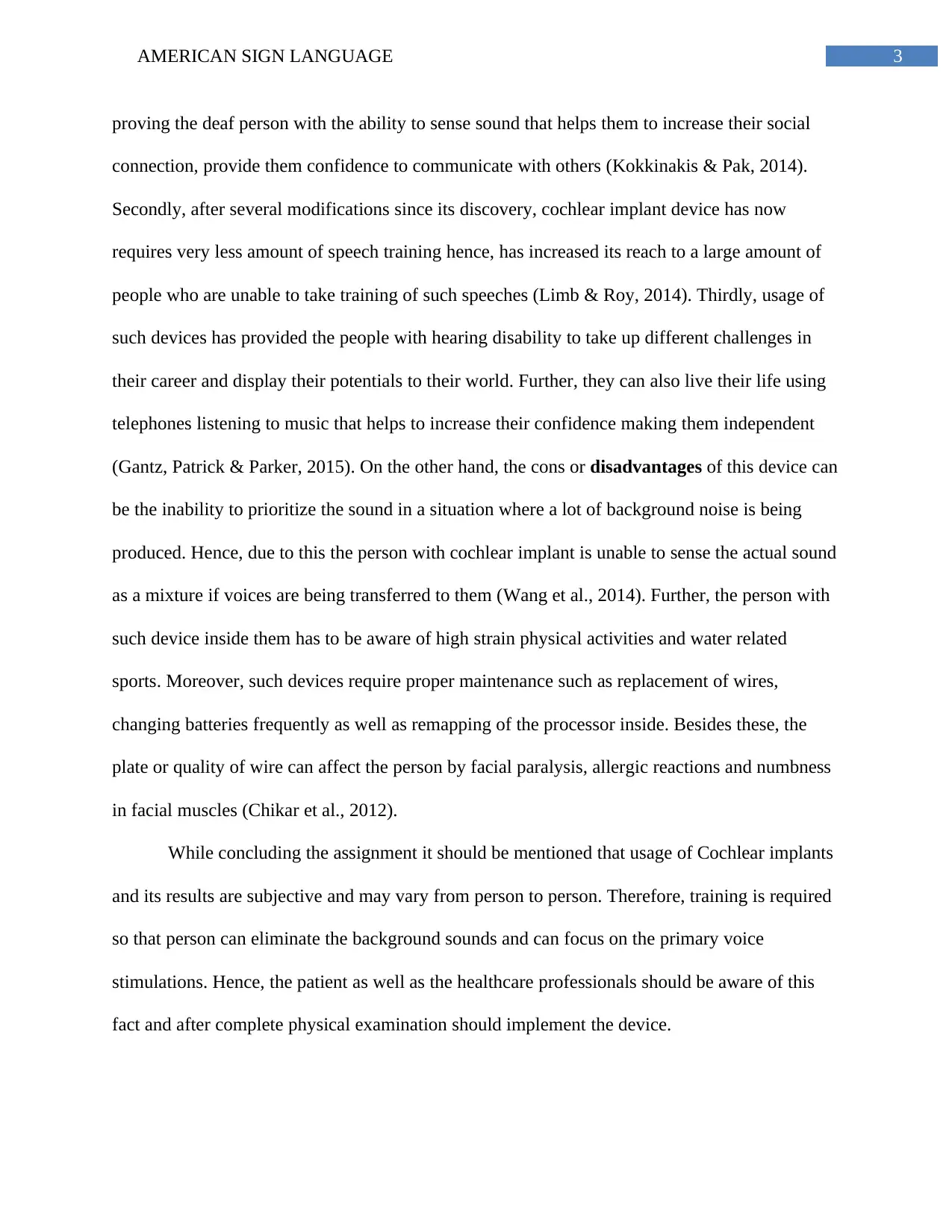
3AMERICAN SIGN LANGUAGE
proving the deaf person with the ability to sense sound that helps them to increase their social
connection, provide them confidence to communicate with others (Kokkinakis & Pak, 2014).
Secondly, after several modifications since its discovery, cochlear implant device has now
requires very less amount of speech training hence, has increased its reach to a large amount of
people who are unable to take training of such speeches (Limb & Roy, 2014). Thirdly, usage of
such devices has provided the people with hearing disability to take up different challenges in
their career and display their potentials to their world. Further, they can also live their life using
telephones listening to music that helps to increase their confidence making them independent
(Gantz, Patrick & Parker, 2015). On the other hand, the cons or disadvantages of this device can
be the inability to prioritize the sound in a situation where a lot of background noise is being
produced. Hence, due to this the person with cochlear implant is unable to sense the actual sound
as a mixture if voices are being transferred to them (Wang et al., 2014). Further, the person with
such device inside them has to be aware of high strain physical activities and water related
sports. Moreover, such devices require proper maintenance such as replacement of wires,
changing batteries frequently as well as remapping of the processor inside. Besides these, the
plate or quality of wire can affect the person by facial paralysis, allergic reactions and numbness
in facial muscles (Chikar et al., 2012).
While concluding the assignment it should be mentioned that usage of Cochlear implants
and its results are subjective and may vary from person to person. Therefore, training is required
so that person can eliminate the background sounds and can focus on the primary voice
stimulations. Hence, the patient as well as the healthcare professionals should be aware of this
fact and after complete physical examination should implement the device.
proving the deaf person with the ability to sense sound that helps them to increase their social
connection, provide them confidence to communicate with others (Kokkinakis & Pak, 2014).
Secondly, after several modifications since its discovery, cochlear implant device has now
requires very less amount of speech training hence, has increased its reach to a large amount of
people who are unable to take training of such speeches (Limb & Roy, 2014). Thirdly, usage of
such devices has provided the people with hearing disability to take up different challenges in
their career and display their potentials to their world. Further, they can also live their life using
telephones listening to music that helps to increase their confidence making them independent
(Gantz, Patrick & Parker, 2015). On the other hand, the cons or disadvantages of this device can
be the inability to prioritize the sound in a situation where a lot of background noise is being
produced. Hence, due to this the person with cochlear implant is unable to sense the actual sound
as a mixture if voices are being transferred to them (Wang et al., 2014). Further, the person with
such device inside them has to be aware of high strain physical activities and water related
sports. Moreover, such devices require proper maintenance such as replacement of wires,
changing batteries frequently as well as remapping of the processor inside. Besides these, the
plate or quality of wire can affect the person by facial paralysis, allergic reactions and numbness
in facial muscles (Chikar et al., 2012).
While concluding the assignment it should be mentioned that usage of Cochlear implants
and its results are subjective and may vary from person to person. Therefore, training is required
so that person can eliminate the background sounds and can focus on the primary voice
stimulations. Hence, the patient as well as the healthcare professionals should be aware of this
fact and after complete physical examination should implement the device.
Paraphrase This Document
Need a fresh take? Get an instant paraphrase of this document with our AI Paraphraser
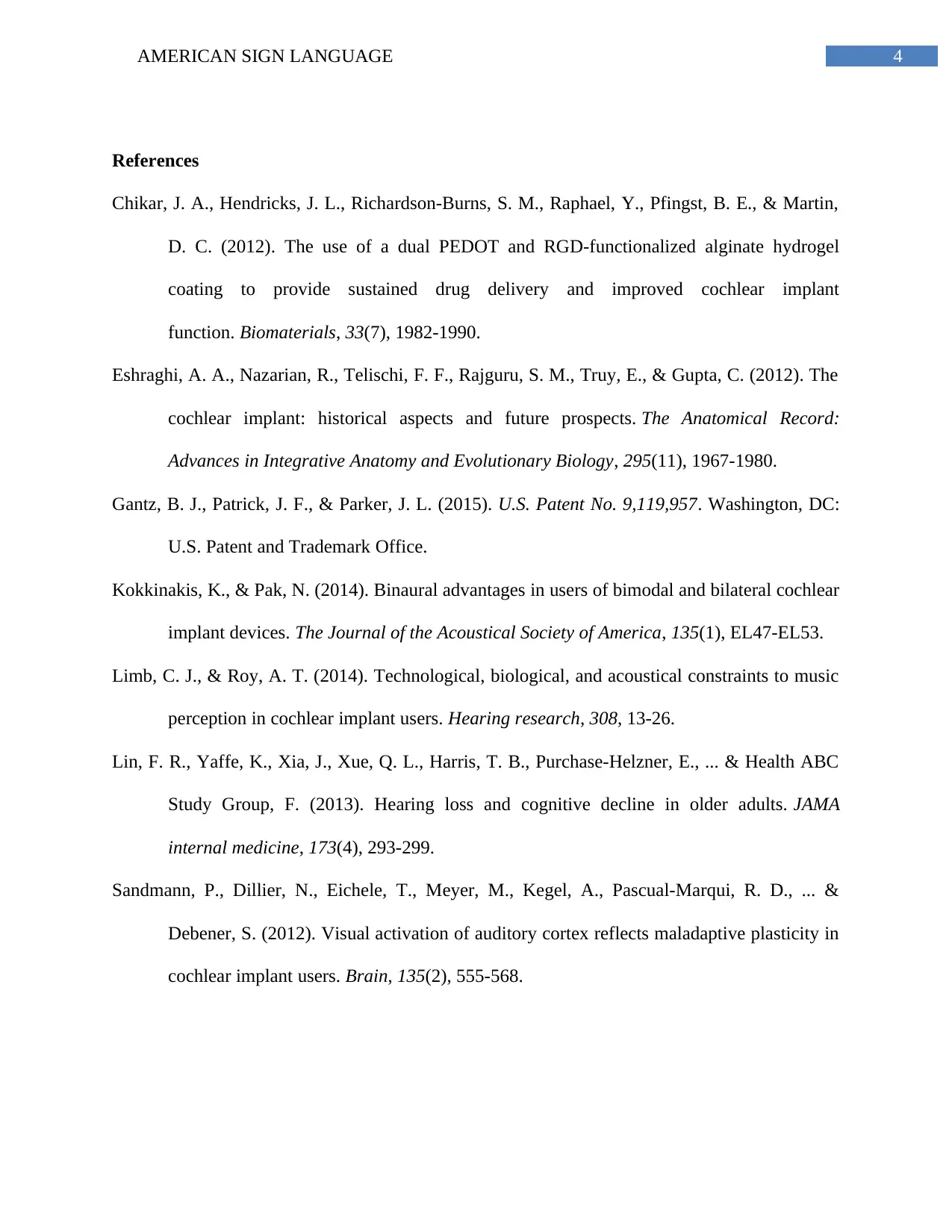
4AMERICAN SIGN LANGUAGE
References
Chikar, J. A., Hendricks, J. L., Richardson-Burns, S. M., Raphael, Y., Pfingst, B. E., & Martin,
D. C. (2012). The use of a dual PEDOT and RGD-functionalized alginate hydrogel
coating to provide sustained drug delivery and improved cochlear implant
function. Biomaterials, 33(7), 1982-1990.
Eshraghi, A. A., Nazarian, R., Telischi, F. F., Rajguru, S. M., Truy, E., & Gupta, C. (2012). The
cochlear implant: historical aspects and future prospects. The Anatomical Record:
Advances in Integrative Anatomy and Evolutionary Biology, 295(11), 1967-1980.
Gantz, B. J., Patrick, J. F., & Parker, J. L. (2015). U.S. Patent No. 9,119,957. Washington, DC:
U.S. Patent and Trademark Office.
Kokkinakis, K., & Pak, N. (2014). Binaural advantages in users of bimodal and bilateral cochlear
implant devices. The Journal of the Acoustical Society of America, 135(1), EL47-EL53.
Limb, C. J., & Roy, A. T. (2014). Technological, biological, and acoustical constraints to music
perception in cochlear implant users. Hearing research, 308, 13-26.
Lin, F. R., Yaffe, K., Xia, J., Xue, Q. L., Harris, T. B., Purchase-Helzner, E., ... & Health ABC
Study Group, F. (2013). Hearing loss and cognitive decline in older adults. JAMA
internal medicine, 173(4), 293-299.
Sandmann, P., Dillier, N., Eichele, T., Meyer, M., Kegel, A., Pascual-Marqui, R. D., ... &
Debener, S. (2012). Visual activation of auditory cortex reflects maladaptive plasticity in
cochlear implant users. Brain, 135(2), 555-568.
References
Chikar, J. A., Hendricks, J. L., Richardson-Burns, S. M., Raphael, Y., Pfingst, B. E., & Martin,
D. C. (2012). The use of a dual PEDOT and RGD-functionalized alginate hydrogel
coating to provide sustained drug delivery and improved cochlear implant
function. Biomaterials, 33(7), 1982-1990.
Eshraghi, A. A., Nazarian, R., Telischi, F. F., Rajguru, S. M., Truy, E., & Gupta, C. (2012). The
cochlear implant: historical aspects and future prospects. The Anatomical Record:
Advances in Integrative Anatomy and Evolutionary Biology, 295(11), 1967-1980.
Gantz, B. J., Patrick, J. F., & Parker, J. L. (2015). U.S. Patent No. 9,119,957. Washington, DC:
U.S. Patent and Trademark Office.
Kokkinakis, K., & Pak, N. (2014). Binaural advantages in users of bimodal and bilateral cochlear
implant devices. The Journal of the Acoustical Society of America, 135(1), EL47-EL53.
Limb, C. J., & Roy, A. T. (2014). Technological, biological, and acoustical constraints to music
perception in cochlear implant users. Hearing research, 308, 13-26.
Lin, F. R., Yaffe, K., Xia, J., Xue, Q. L., Harris, T. B., Purchase-Helzner, E., ... & Health ABC
Study Group, F. (2013). Hearing loss and cognitive decline in older adults. JAMA
internal medicine, 173(4), 293-299.
Sandmann, P., Dillier, N., Eichele, T., Meyer, M., Kegel, A., Pascual-Marqui, R. D., ... &
Debener, S. (2012). Visual activation of auditory cortex reflects maladaptive plasticity in
cochlear implant users. Brain, 135(2), 555-568.
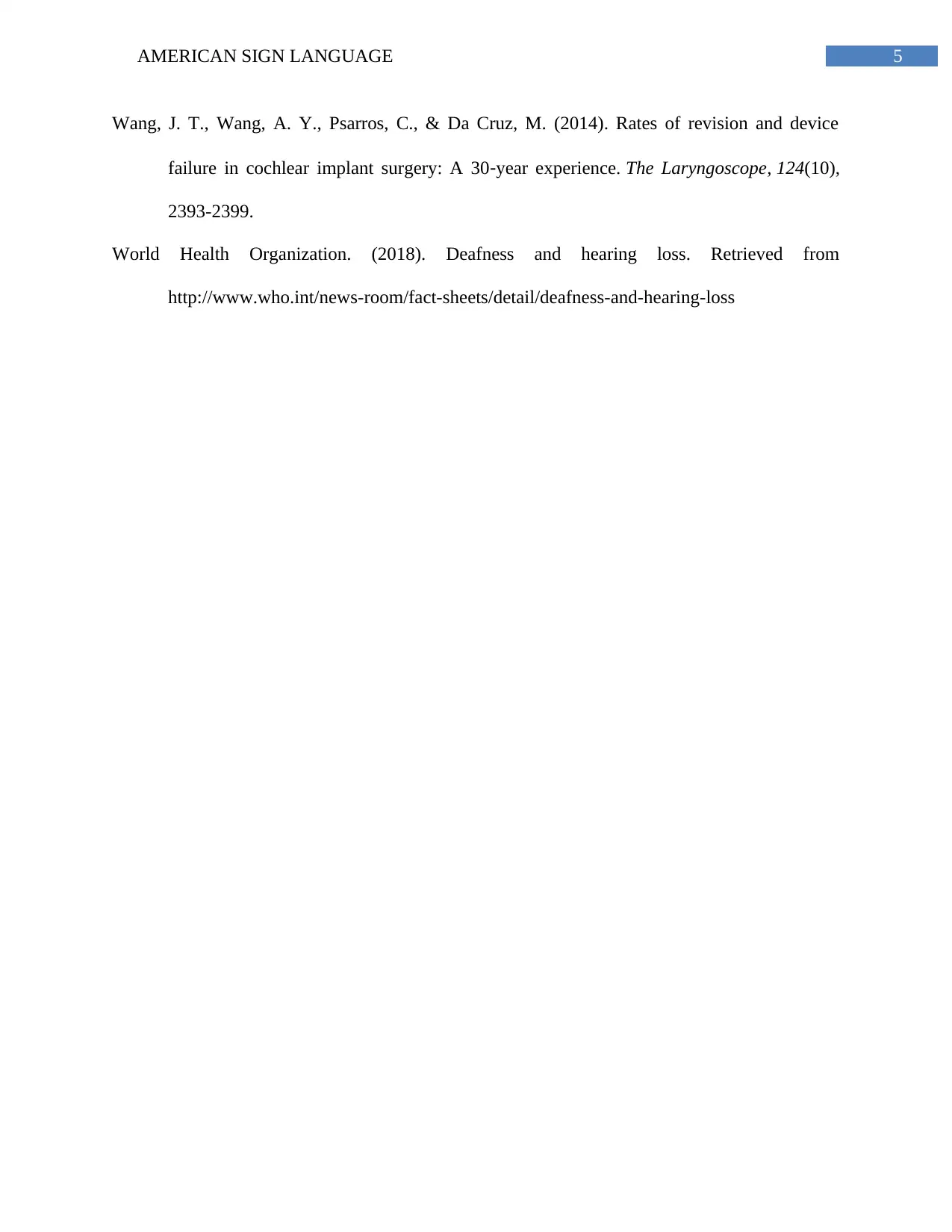
5AMERICAN SIGN LANGUAGE
Wang, J. T., Wang, A. Y., Psarros, C., & Da Cruz, M. (2014). Rates of revision and device
failure in cochlear implant surgery: A 30‐year experience. The Laryngoscope, 124(10),
2393-2399.
World Health Organization. (2018). Deafness and hearing loss. Retrieved from
http://www.who.int/news-room/fact-sheets/detail/deafness-and-hearing-loss
Wang, J. T., Wang, A. Y., Psarros, C., & Da Cruz, M. (2014). Rates of revision and device
failure in cochlear implant surgery: A 30‐year experience. The Laryngoscope, 124(10),
2393-2399.
World Health Organization. (2018). Deafness and hearing loss. Retrieved from
http://www.who.int/news-room/fact-sheets/detail/deafness-and-hearing-loss
⊘ This is a preview!⊘
Do you want full access?
Subscribe today to unlock all pages.

Trusted by 1+ million students worldwide
1 out of 6
Related Documents
Your All-in-One AI-Powered Toolkit for Academic Success.
+13062052269
info@desklib.com
Available 24*7 on WhatsApp / Email
![[object Object]](/_next/static/media/star-bottom.7253800d.svg)
Unlock your academic potential
Copyright © 2020–2025 A2Z Services. All Rights Reserved. Developed and managed by ZUCOL.





